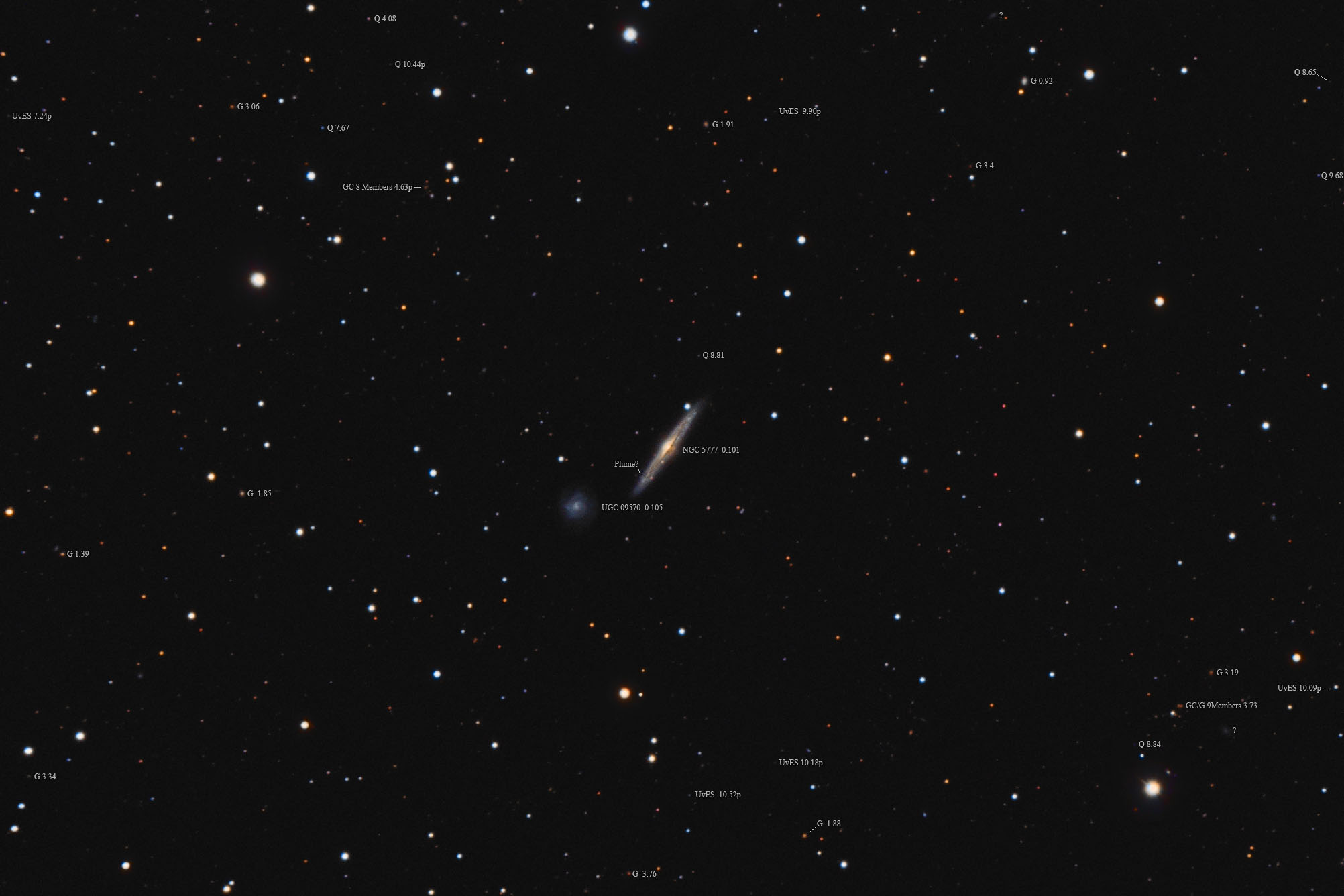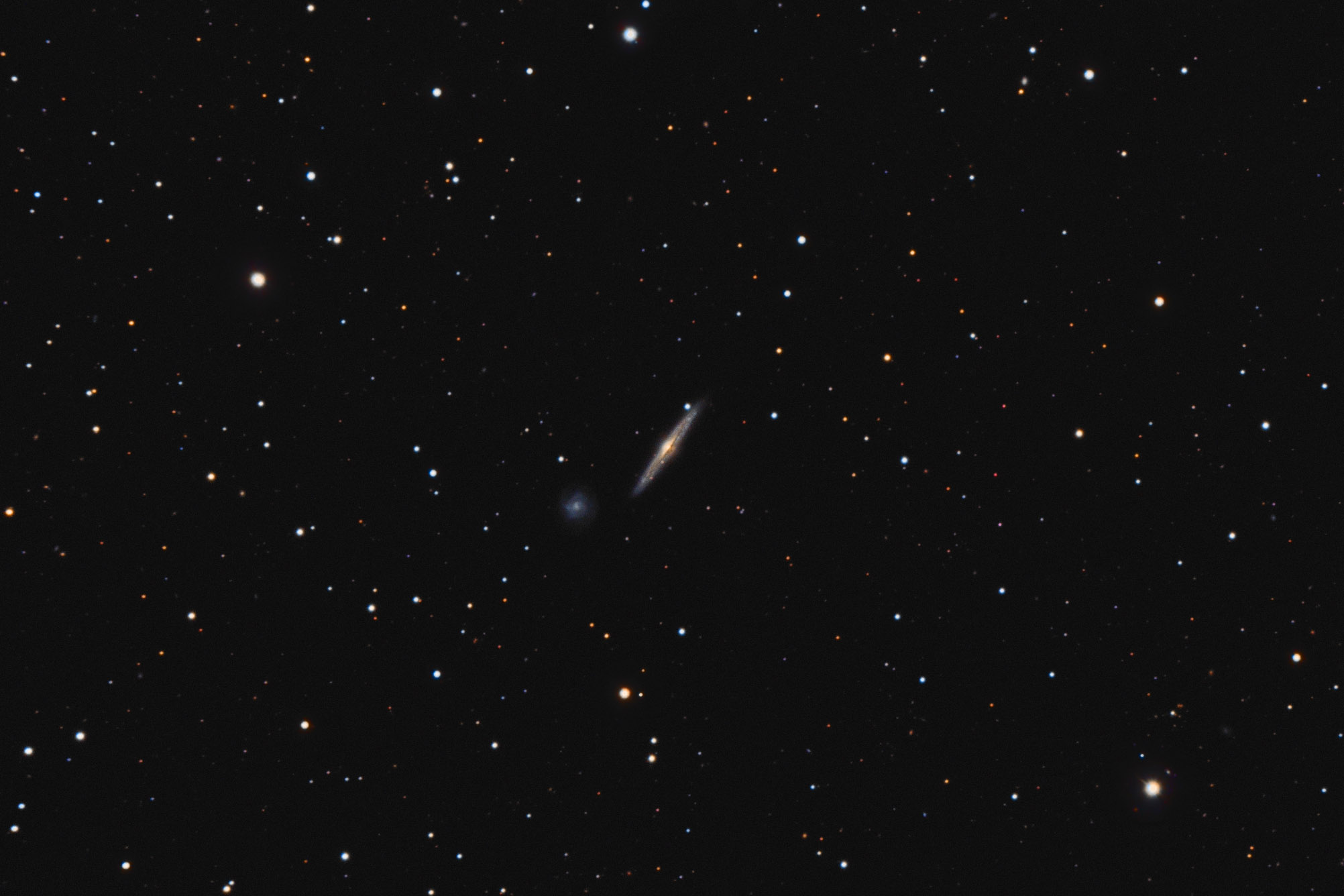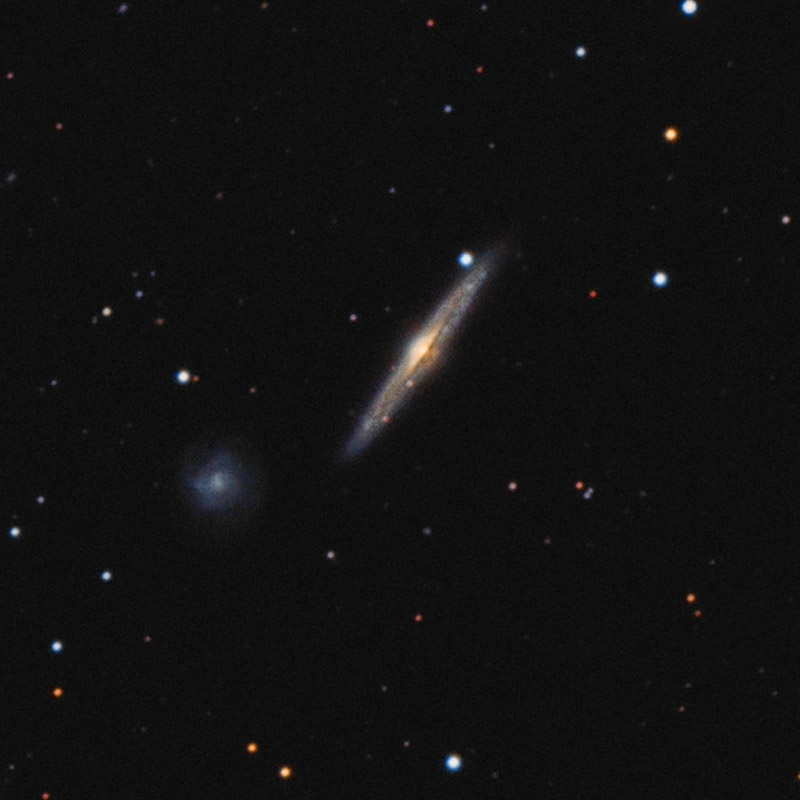Object name: NGC5777Designation(s): NGC5777, UGC09570, NGC 5777 and UGC 09570 are a pair of galaxies in Draco about 100 million light-years away. NED classes NGC 5777 as Sbc and as having a narrow line AGN at its core. The NGC project says simply it is an Sb spiral. In any case, it is seen nearly edge-on making such details hard to see. One paper says that it has a plume. My annotated image points to the "plume" though I see only a slight "bump" to the edge of the galaxy at that point. The paper's image has had the stars removed making it hard to determine where it is looking. My brain can't comprehend mirrored images very well either and theirs is a mirror image of a standard presentation. http://articles.adsabs.harvard.edu/cgi-bin/nph-iarticle_query?1994ApJ...427..160P&data_type=PDF_HIGH&whole_paper=YES&type=PRINTER&filetype=.pdf
It was discovered by William Herschel on April 17, 1789. It's not in either of the H400 programs.
The companion, UGC 09570 is listed as a dwarf spiral at NED with about the same redshift indicating it is likely a true companion. Its spiral structure is very fuzzy.
The field contains 12 quasars (Q) or quasar candidates (UvES). I wonder what Arp would have made of that since NGC 5777 doesn't look all that disturbed. The disk does appear very slightly warped but that's it. Arp thought quasars clustered about disturbed galaxies and were thus emitted by them rather than being distant black holes in early galaxies. This was just a selection effect, quasars were first found in well-studied fields such as those containing disturbed galaxies. Turns out they are just as common around more ordinary galaxies as this field shows. Few take his ideas seriously any more but last I heard he was still clinging to them.
I found a couple galaxy clusters in the image. WHL J145204.3+590518 with 8 members is to the upper left of NGC 5777. It had a redshift for only the cluster whose position was close (within a couple seconds of arc) of the bright cluster galaxy at its core though there was no redshift for the galaxy, it was listed as being the BCG of the group. The line in the annotated image points to the galaxy. In the lower right is GMBCG J222.41286+58.86499 with 9 members. Here NED lists the same photographic z value and position for the cluster and BCG. As mentioned in previous posts the photographic redshift value is usually less accurate than a spectroscopic redshift but the two, when present, are relatively similar so it is usually reliable to give a general idea of relative distance.
As usual, I stumbled across a couple low surface brightness blue galaxies not listed at NED at all. Some systematic error is omitting them it would appear. Again, these are just two I happened to check, the vast majority weren't looked at so others have likely been overlooked.
14" LX200R @ f/10, L=4x10' RGB=2x10', STL-11000XM, Paramount MENGC 5777 and UGC 09570 are a pair of galaxies in Draco about 100 million light-years away. NED classes NGC 5777 as Sbc and as having a narrow line AGN at its core. The NGC project says simply it is an Sb spiral. In any case, it is seen nearly edge-on making such details hard to see. One paper says that it has a plume. My annotated image points to the "plume" though I see only a slight "bump" to the edge of the galaxy at that point. The paper's image has had the stars removed making it hard to determine where it is looking. My brain can't comprehend mirrored images very well either and theirs is a mirror image of a standard presentation. http://articles.adsabs.harvard.edu/cgi-bin/nph-iarticle_query?1994ApJ...427..160P&data_type=PDF_HIGH&whole_paper=YES&type=PRINTER&filetype=.pdf
The companion, UGC 09570 is listed as a dwarf spiral at NED with about the same redshift indicating it is likely a true companion. Its spiral structure is very fuzzy.
The field contains 12 quasars (Q) or quasar candidates (UvES). I wonder what Arp would have made of that since NGC 5777 doesn't look all that disturbed. The disk does appear very slightly warped but that's it. Arp thought quasars clustered about disturbed galaxies and were thus emitted by them rather than being distant black holes in early galaxies. This was just a selection effect, quasars were first found in well-studied fields such as those containing disturbed galaxies. Turns out they are just as common around more ordinary galaxies as this field shows. Few take his ideas seriously any more but last I heard he was still clinging to them. (Edit: Since this was written he has died. I hope taking his odd idea with him. He was a top astronomer prior to getting this idea stuck in his brain.)
I found a couple galaxy clusters in the image. WHL J145204.3+590518 with 8 members is to the upper left of NGC 5777. It had a redshift for only the cluster whose position was close (within a couple seconds of arc) of the bright cluster galaxy at its core though there was no redshift for the galaxy, it was listed as being the BCG of the group. The line in the annotated image points to the galaxy. In the lower right is GMBCG J222.41286+58.86499 with 9 members. Here NED lists the same photographic z value and position for the cluster and BCG. As mentioned in previous posts the photographic redshift value is usually less accurate than a spectroscopic redshift but the two, when present, are relatively similar so it is usually reliable to give a general idea of relative distance.
As usual, I stumbled across a couple low surface brightness blue galaxies not listed at NED at all. Some systematic error is omitting them it would appear. Again, these are just two I happened to check, the vast majority weren't looked at so others have likely been overlooked. (Edit: Since this was written I've found NED often has this as an Ultraviolet source but not as a galaxy. It returns hundreds of such sources, nearly all blue stars and sorting out the few galaxies is apparently beyond their computer's ability. I certainly don't have the time to try and sort through them all. Once in a rare while, NED does show one as a galaxy and I'll note that. None were in this image.)
14" LX200R @ f/10, L=4x10' RGB=2x10', STL-11000XM, Paramount ME Related Designation(s):2MASS J14511791+5858394, 2MASX J14511779+5858401, 2MASXi J1451187+585842, AKARI J1451173+585835, ASK 109584.0, ASK 109587.0, ASK 110372.0, CGCG 1450.0+5910, CGCG 296-018, EON J222.830+58.978, FGC 1822, IRAS 14499+5910, IRAS F14499+5910, ISOSS J14513+5858, MCG +10-21-034, MCG +10-21-035, NGC 5777, NGC5777, NSA 019647, NSA 165707, NVSS J145117+585843, PGC 053043, PGC 053057, RFGC 2878, SDSS J145117.82+585840.6, SDSS J145117.84+585840.6, SDSS J145117.84+585840.9, SDSS J145117.91+585841.6, SDSS J145117.91+585841.7, SDSS J145117.95+585841.9, SDSS J145135.92+585713.8, SDSS J145135.92+585713.9, SDSS J145135.93+585713.8, UGC 09568, UGC 09570, UGC09570, UZC J145118.0+585841, [LG2007] 68, [SLK2004] 1058, | | 

